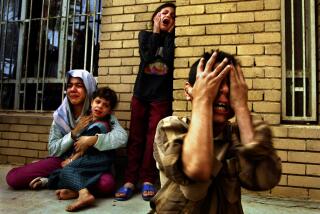War Comes to the Green Zone
- Share via
Two suicide bombers met for lunch Thursday and then blew themselves up in the heart of the Green Zone, the home of the coalition and interim Iraqi government’s leadership. Despite the fact that many American civilians, including some media members, reside within or regularly travel to the Green Zone, the American public has, at best, been offered a caricature of what life in the Green Zone is really like.
The Associated Press says the Green Zone “resemble[s] a suburban ‘Little America’ in central Baghdad -- with green lawns, restaurants, American television, U.S. area codes, even at least one swimming pool set up behind barricades and multiple checkpoints.” Yet this same report fails to mention that most Americans -- like me -- and our coalition partners live in dressed-up shipping containers. The residential trailers are surrounded by ever-deteriorating sandbags that are not there for aesthetic purposes. I do not remember seeing many green lawns when I was there for three months this spring, but I have many memories of bombed-out buildings. Little America? Actually, it’s a far cry from Topeka, Kan.
Government employees in the Green Zone regularly work seven days a week and up to 18 hours per day. Meals are taken military-style in communal dining facilities. It made my previous life as a corporate attorney on Wall Street seem like a part-time job. The normal workday is often interrupted with little annoyances, such as head counts to ensure that a staff member has not been blown up in the most recent car bombing at one of the checkpoints or when running to the bomb shelter as insurgents begin walking in mortars and rockets.
For security reasons, stories on the dangers to those who live and work in the Green Zone generally do not find their way into the media, thus leaving Americans with the impression that those inside the Green Zone live without danger. But just last week I received an e-mail from a friend reporting that a mortar round landed but didn’t explode in a Green Zone tent housing 15 men. It’s as if it never really happened.
Also unreported was the incident of the college student who worked down the hall from me for the Ministry of the Interior. He took a year off from school to dedicate himself to a cause in which he truly believed. He and his vehicle was riddled with bullets as he returned from a grass-roots, democracy-building event at Baghdad University. His life was saved when members of the Iraqi police pulled him out and raced him to the Green Zone. Just another day in Little America.
Violence is not a new phenomenon for those who live in the Green Zone, and it comes in waves. It is likely to increase as we approach the milestones of both our own election and the historic Iraqi election set for late January.
A rise in violence in and of itself does not necessarily signify that we are on the wrong path in Iraq. On the contrary, our nihilist enemies who seek to prevent democracy from taking root in the middle of the Arab world will rely on more aggressive and desperate acts of terror as we assist the Iraqi people in moving closer to their vision of a free Iraq.
There are regular cries for “supporting the troops.” Not only do our troops deserve our respect but so do the civilians who tirelessly labor in the Green Zone. Though there is indeed a swimming pool, and even a pizza shack, these creature comforts are a far cry from everyday life in middle America.
I am perplexed by descriptions such as the one in the Associated Press almost implying that Zagat is about to publish its inaugural guide to dining and night life in the Green Zone.
I can see it now: “The tasty chicken sandwich has only a 50% chance of giving you food poisoning, but it is hard to maintain a conversation over the din of small-arms fire in the distance and pesky medevac helicopters hovering overhead.” In short, green -- the symbol of safety -- is a relative color.
More to Read
Sign up for Essential California
The most important California stories and recommendations in your inbox every morning.
You may occasionally receive promotional content from the Los Angeles Times.










